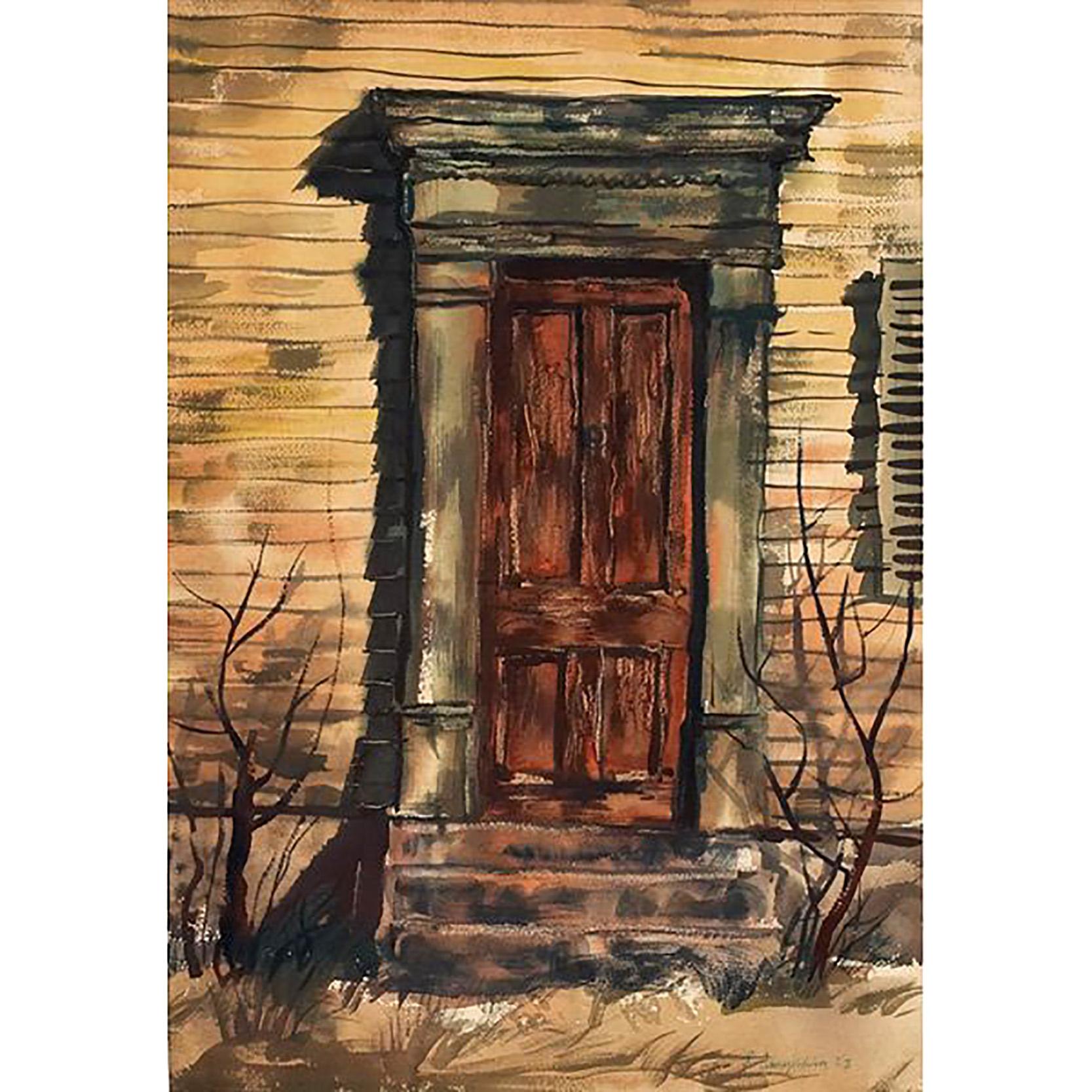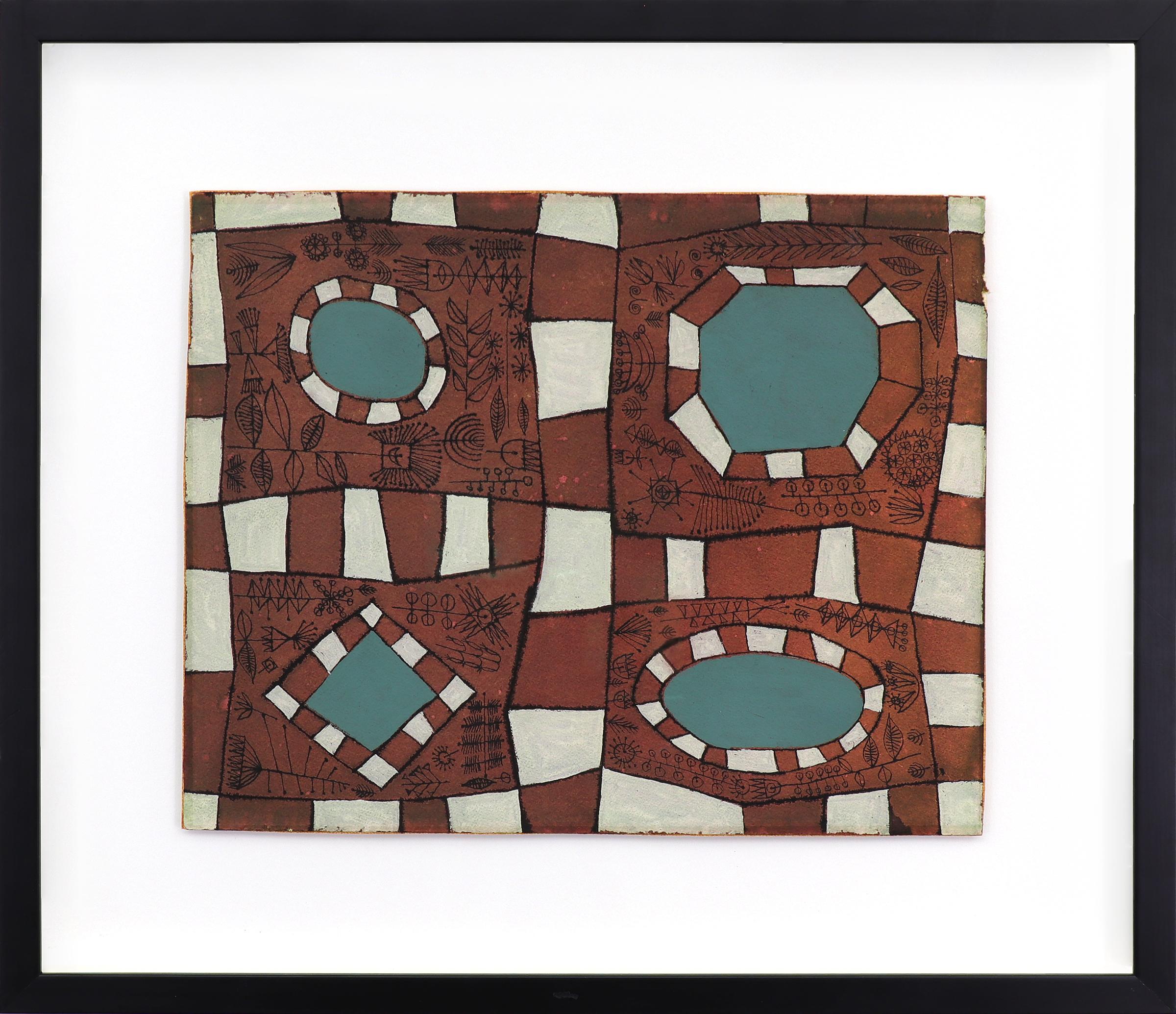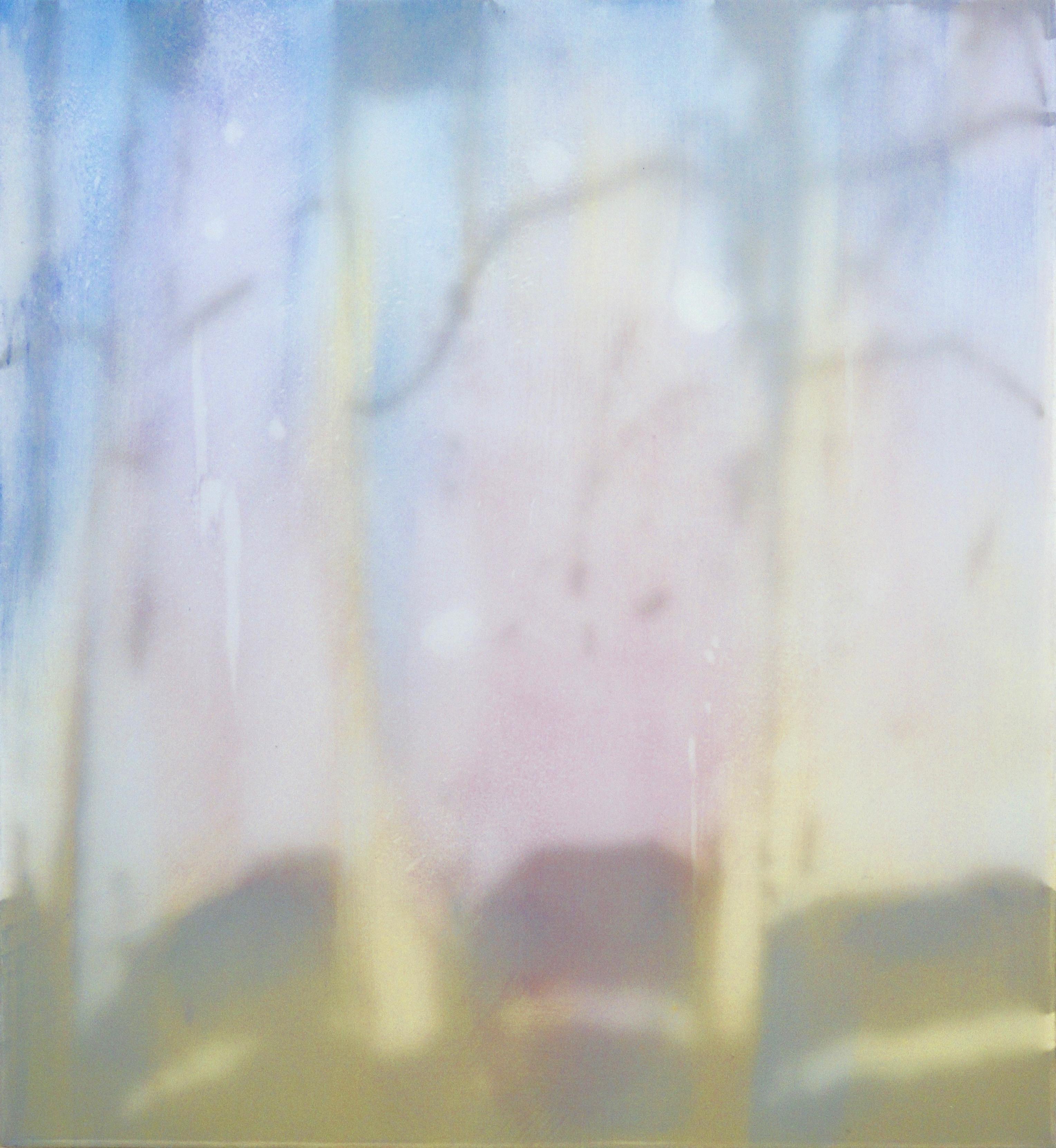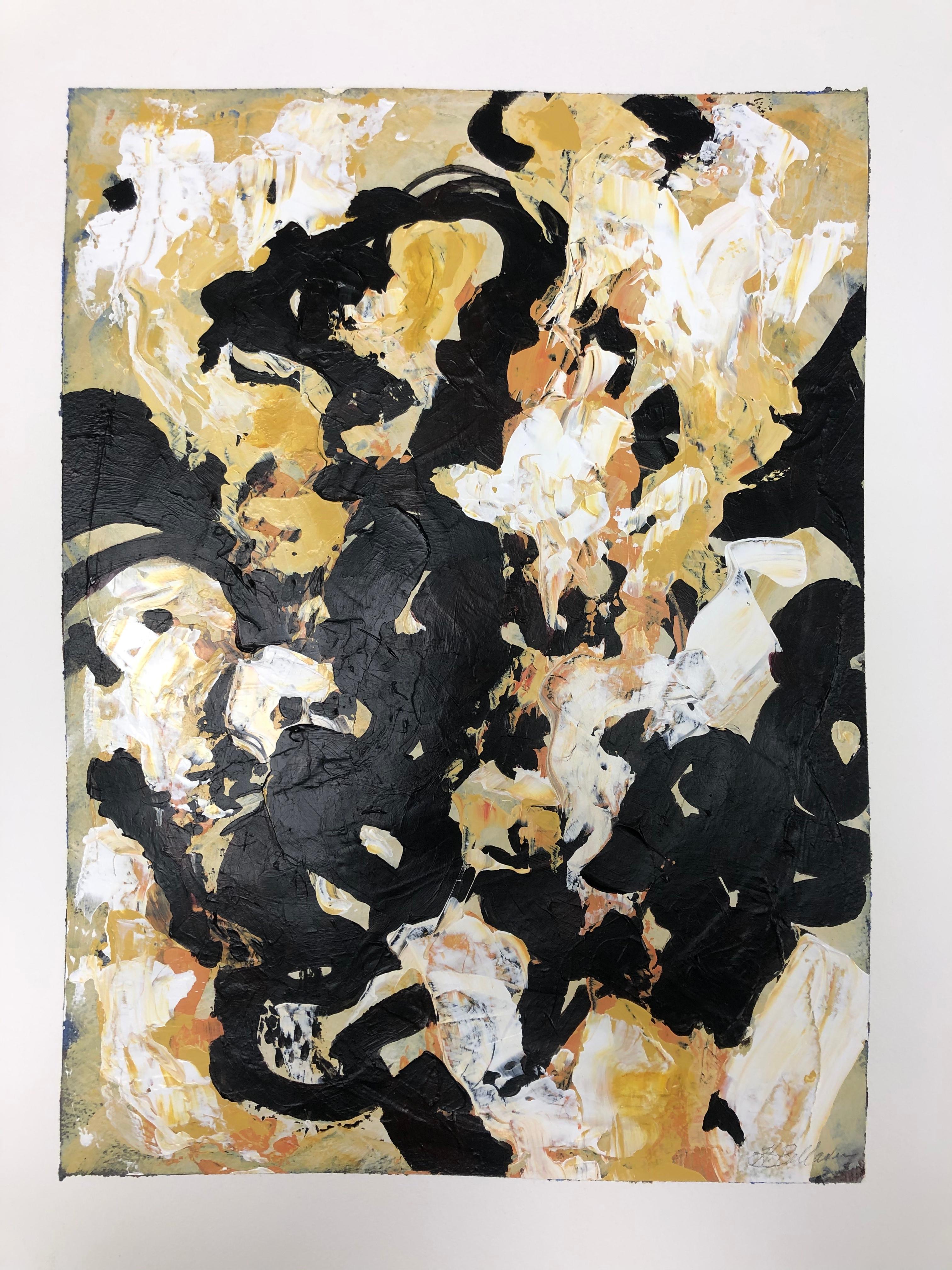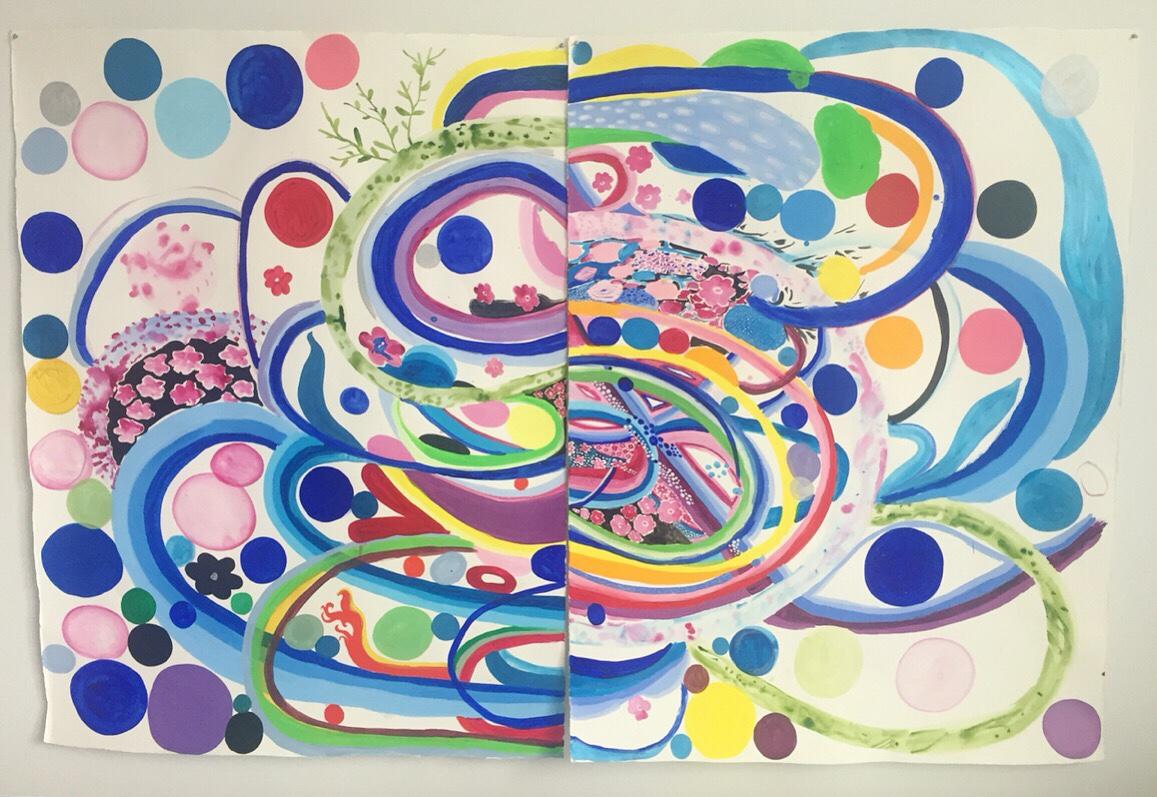Items Similar to Mountains
Want more images or videos?
Request additional images or videos from the seller
1 of 6
Omar RayoMountains1955
1955
About the Item
An early painting by Omar Rayo from 1955. An abstract geometric work with multi-colored shapes on a surrealist horizon.
Artist: Omar Rayo, Colombian (1928 - )
Title: Mountains
Year: 1955
Medium: Acrylic on Paper, signed and dated u.l.
Size: 13.5 in. x 20 in. (34.29 cm x 50.8 cm)
Frame Size: 22 x 28.5 inches
- Creator:Omar Rayo (1928 - 2010)
- Creation Year:1955
- Dimensions:Height: 22 in (55.88 cm)Width: 28.5 in (72.39 cm)
- Medium:
- Movement & Style:
- Period:
- Condition:
- Gallery Location:Long Island City, NY
- Reference Number:1stDibs: LU4664997881
About the Seller
4.8
Platinum Seller
These expertly vetted sellers are 1stDibs' most experienced sellers and are rated highest by our customers.
Established in 1979
1stDibs seller since 2014
2,690 sales on 1stDibs
Typical response time: <1 hour
- ShippingRetrieving quote...Ships From: Long Island City, NY
- Return PolicyA return for this item may be initiated within 7 days of delivery.
More From This SellerView All
- Dan Teis, Abstract Acrylic Painting with CollageBy Dan TeisLocated in Long Island City, NYThis is an acrylic painting on canvas by American artist Dan Teis. This work follows his signature style, geometric compositions in acrylic and paper collage on canvas. His work achi...Category
1970s Abstract Geometric Abstract Paintings
MaterialsCanvas, Paper, Acrylic
- Abstract Acrylic Painting with CollageBy Dan TeisLocated in Long Island City, NYThis is an acrylic painting on canvas by American artist Dan Teis. This work follows his signature style, geometric compositions in acrylic and paper collage on canvas. His work achi...Category
1970s Abstract Geometric Abstract Paintings
MaterialsCanvas, Acrylic
- Variants, Acrylic Painting by Irwin McFaddenBy Irwin McFaddenLocated in Long Island City, NYArtist: Irwin McFadden, American Title: Variants Year: 1972 Medium: Acrylic on Canvas, signed and dated verso Size: 19.5 in. x 19.5 in. (49.53 cm x 49.53 cm) Frame Size: 25 x 25 inchesCategory
1970s Abstract Geometric Abstract Paintings
MaterialsAcrylic
- Kinetic Energy, Abstract Geometric Acrylic Painting by Genero MorenoBy Genaro MorenoLocated in Long Island City, NYArtist: Genaro Moreno, Venezuelan (1921 - 1991) Title: Kinetic Energy Year: 1981 Medium: Acrylic on Canvas, signed l.r. Size: 23 x 19 in. (58.42 x 48.26 cm)Category
1980s Abstract Geometric Abstract Paintings
MaterialsAcrylic
- Shoot the Moon, Large Abstract Painting by Mark LewisBy Mark LewisLocated in Long Island City, NYArtist: Mark Lewis Title: Shoot the Moon 4 Year: circa 1980 Medium: Acrylic on Canvas, signed l.r. Size: 48 x 72 in. (121.92 x 182.88 cm) Frame Size: 51...Category
1980s Abstract Geometric Abstract Paintings
MaterialsCanvas, Acrylic
- M R3 C5, Abstract Acrylic Painting by Tony KingBy Tony KingLocated in Long Island City, NYArtist: Tony King Year: 1975 Title: M R3 C5 Medium: Acrylic on Canvas Canvas Size: 48 x 48 inches (121.92 x 121.92 cm) Frame Size: 49 x 49 inches (124.46 x 1...Category
1970s Abstract Geometric Abstract Paintings
MaterialsCanvas, Acrylic
You May Also Like
- Old DoorBy Richard AnuszkiewiczLocated in New York, NYRichard Anuszkiewicz Old Door, 1953 Watercolor on paper Signed and dated by the artist on the lower right front 20 × 14 inches Unframed This unique and extre...Category
1950s Abstract Geometric Landscape Drawings and Watercolors
MaterialsPaper, Watercolor
- Tayo Heuser, Nomad, 2013, Ink on handburnished paper, Abstraction, MeditativeBy Tayo HeuserLocated in Darien, CTBy developing a geometry between line and the spaces in between in their work, the abstract paintings of Tayo Heuser create a point of departure for the mind into a spiritual consci...Category
2010s Abstract Geometric Abstract Paintings
MaterialsPigment, Paper, Ink, Handmade Paper
- A Small City Park, Abstract Painting Acrylic Watercolor Painting, Green BrownBy Edward MarecakLocated in Denver, CO"A Small City Park", acrylic and watercolor on paper by Denver artist Edward Marecak (1919-1993) of an abstract park broken into four quadrants, separated by brown and white striped borders with different shaped ponds. Inspired by City Park in Denver, Colorado where the artist frequented. Presented framed with all archival materials, outer dimensions measure 21 ¾ x 18 ¾ inches. Image size measures 12 x 15 inches. Painting is clean and in good condition - please contact us for a detailed condition report. Provenance: Estate of Edward Marecak Expedited and international shipping is available - please contact us for a quote. About the Artist: Born to immigrant parents from the Carpathian region in Slovakia, Marecak grew up with his family in the farming community of Bennett’s Corners, now part of the town of Brunswick, near Cleveland, Ohio. When he turned twelve, his family moved to a multi-ethnic neighborhood of Poles, Czechs, Slovaks and Slovenians in Cleveland. His childhood household cherished the customs and Slavic folk tales from the Old Country that later strongly influenced his work as a professional artist. During junior high he painted scenery for puppet shows of "Peter and the Wolf," awakening his interest in art. In his senior year in high school he did Cézanne-inspired watercolors of Ohio barns at seventy-five cents apiece for the National Youth Administration. They earned him a full scholarship to the Cleveland Institute of Art (1938-1942) where he studied with Henry George Keller whose work was included in the 1913 New York Armory Show. In 1940 Marecak also taught at the Museum School of the Cleveland Institute. Before being drafted into the military in 1942, he briefly attended the Cranbrook Academy of Art near Detroit, one of the nation’s leading graduate schools of art, architecture, and design. A center of innovative work in architecture, art and design with an educational approach built on a mentorship model, it has been home to some of the world’s most renowned designers and artists, including Eero Saarinen, Charles Eames, Daniel Libeskind and Harry Bertoia. Marecak’s studies at Cranbrook with painter Zoltan Sepeshy and sculptor Carl Milles were interrupted by U.S. army service in the Aleutian Islands during World War II. Following his military discharge, Marecak studied on the G.I. Bill at the Colorado Springs Fine Arts Center from 1946 to 1950, having previously met its director, Boardman Robinson, conducting a seminar in mural painting at the Cleveland Institute of Art. Although he did not work with Robinson at the Fine Arts Center, who had become quite ill - retiring in 1947 - he studied Robinson’s specialty of mural painting before leaving to briefly attend the Cranbrook Academy in 1947. That same year he returned to the Fine Arts Center, studying painting with Jean Charlot and Mary Chenoweth, and lithography with Lawrence Barrett with whom he produced some 132 images during 1948-49. At the Fine Arts Center he met his future wife, Donna Fortin, whom he married in 1947. Also a Midwesterner, she had taken night art courses at Hull House in Chicago, later studying at the Art Institute of Chicago with the encouragement of artist Edgar Britton. After World War II she studied with him from 1946 to 1949 at the Fine Arts Center. (He had moved to Colorado Springs to treat his tuberculosis.) Ed Marecak also became good friends with Britton, later collaborating with him on the design of large stained glass windows for a local church. In 1950-51 Marecak returned to the Cleveland Institute of Art to complete his Bachelor of Fine Arts degree. A year later he was invited to conduct a summer class at the University of Colorado in Boulder, confirming his interest in the teaching profession. In 1955 he received his teaching certificate from the University of Denver. Vance Kirkland, the head of its art department, helped him get a teaching job with the Denver Public Schools so that he and his family could remain in the Mile High City. For the next twenty-five years he taught art at Skinner, Grove, East, George Washington and Morey Junior High Schools. Prior to coming to Colorado, Marecak did watercolors resembling those of Winslow Homer, John Singer Sargent and Charles Burchfield. However, once in Colorado Springs he decided to destroy much of his earlier ouevre, embarking on a totally new direction unlike anything he had previously done. Initially, in the 1940s he was influenced by surrealist imagery and Paul Klee, and in the West by Indian petroglyphs and Kachinas. His first one-person show at the Garrett Gallery in Colorado Springs in 1949 featured paintings and lithographs rendered in the style of Magic Realism and referential abstraction. The pieces, including an oil Witch with Pink Dish, foreshadowed the output of his entire Colorado-based career, distinguished by a dramatic use of color, intricacy of execution and attention to detail contributing to their visual impact. He once observed, "Each time I start a new painting I always fool myself by saying this time keep it simple and not get entangled with such complex patterns, color and design; but I always find myself getting more involved with richness, color and subject matter." An idiosyncratic artist proficient in oil, acrylic, watercolor, gouache and casein, he did not draw upon Colorado subject matter for his work, unlike many of his fellow painters in the state. Instead he used Midwest landscape imagery, bringing to life in it witches and spirits adapted from the Slovakian folk tales he heard growing up in Ohio. A number of his paintings depict winter witches derived from the Slovak custom in the Tatra Mountains of burning an effigy of the winter witch in the early spring to banish the memory of a hard winter. The folk tale element imparts a dream-like quality to many of his paintings. A devote of Greek mythology, he placed the figures of Circe, Persephone, Sybil, Hera and others in modern settings. The goddess in Persephone Brings a Pumpkin to her Mother, attired as a Midwestern farmer’s daughter, heralds the advent of fall with the pumpkin before departing to spend the winter season in the underworld. Train to Olympus, the meeting place of the gods in ancient Greece, juxtaposes ancient mythology with modernity creating a combination of whimsy and thought-provoking consideration for the viewer. Voyage to Troy #1 alludes to the ancient city that was the site of the Trojan Wars, but has a contemporary, autobiographical component referencing the harbor of the Aleutian Islands recaptured from the Japanese during World War II. In the 1980s Marecak used the goddess Hera in his painting, Hera Contemplates Aspects of the Art Nouveau, to comment on art movements in the latter half of the twentieth century Marecak’s love of classical music and opera, which he shared with his wife and to which he often listened while painting in his Denver basement studio, is reflected in Homage of Offenbach, an abstract work translating the composer’s musical colors into colorful palette. Pace, Pace, Mio Dio, the title of his earliest surrealist painting, is a soprano aria from Verdi’s opera, La Forza del Destino (The Force of Destiny or Fate, a favorite Marecak subject). His Queen of the Night relates to a character from Mozart’s opera, The Magic Flute. In addition to paintings and works on paper, he produced hooked rugs, textiles and ceramics. He likewise produced designs for ceramics, tableware and furniture created by his wife Donna, an accomplished Colorado ceramist. Both of them generally eschewed exhibitions and galleries, preferring to quietly do their work while remaining outside of the mainstream. He initially exhibited at the Colorado Springs Fine Arts Center in 1948 receiving a purchase award. The following year he had his first one-person show of paintings and lithographs at the Garrett Gallery in Colorado Springs. In the 1950s and early 1960s he participated in group exhibitions at the Print Club (Philadelphia); Amarillo Public Library (Texas); annual Blossom Festival Show (Canon City, Colorado); Adele Simpson’s "Art of Living" in New York; Denver Art Museum; and the Fox Rubenstein-Serkey Gallery (Denver); but he did not have another one-person show until 1966 at the Denver home of his friends, John and Gerda Scott. They arranged for his first one-person show outside of Colorado held two years later at the Martin Lowitz Gallery in Beverly Hills and Palm Springs, California. That same year his work was featured at the Zantman Galleries in Carmel, California. Thereafter he became an infrequent exhibitor after the 1970s so that his work was rarely seen outside his basement studio. In 1980 he, his wife and Mark Zamantakis exhibited at Denver’s Jewish Community Center, and four years later he had a one-person show at the Studio Gallery in Denver. In 1992 he was included in a group show at the Rule Modern and Contemporary Gallery in Denver, and a year later received a large, posthumous retrospective at the Emmanuel...Category
Mid-20th Century Abstract Abstract Paintings
MaterialsPaper, Acrylic, Watercolor
- WINDOW V - Contemporary Abstract Mixed Media Painting, shadow, curtains, blueBy Heather HartmanLocated in Signal Mountain, TNWINDOW V captures the soft patterned shadow of the trees veiled by a sheer curtain. This painting is is part of an on-going series that explores the light and landscape in Tennessee....Category
2010s Abstract Abstract Paintings
MaterialsPolyester, Oil, Acrylic, Gouache, Mesh
- Abstract 62 - Abstract Expressionist Mixed Media (Black + White + Yellow + Gold)By Helen BellaverLocated in Gilroy, CA"Abstract 62," is a contemporary Abstract painting by San Jose-based artist Helen Bellaver. In this work, Helen layers a medium onto her paper to create a subtle texture, which she t...Category
2010s Contemporary Abstract Paintings
MaterialsAcrylic, Archival Paper, Mixed Media
- Wide and Wild Big DiptychBy Nina BovassoLocated in New York, NYThis is a large diptych on paper, 68 x 101 inches, created in 2020. What is unique to this one is the wider horizontal width. I think of my large diptychs as simultaneously a figure...Category
2010s Abstract Paintings
MaterialsAcrylic, Watercolor, Gouache, Archival Paper, Ink
Recently Viewed
View AllMore Ways To Browse
White Mountains Paintings
1950 Mountain Paintings
Geometric Horizon
La Union
Used Brunswick
Lo Lo
The Plaza
Korean Modern Art
10 X 8 Abstract
Two Piece Painting Wall Art
White Paintings Minimal
Black And White Geometric Painting
Acrylic Pouring Painting
1950 S Abstract Paintings
Abstract Geometric Circle
Retro Window Frames
Black Guild
70s Canvas
